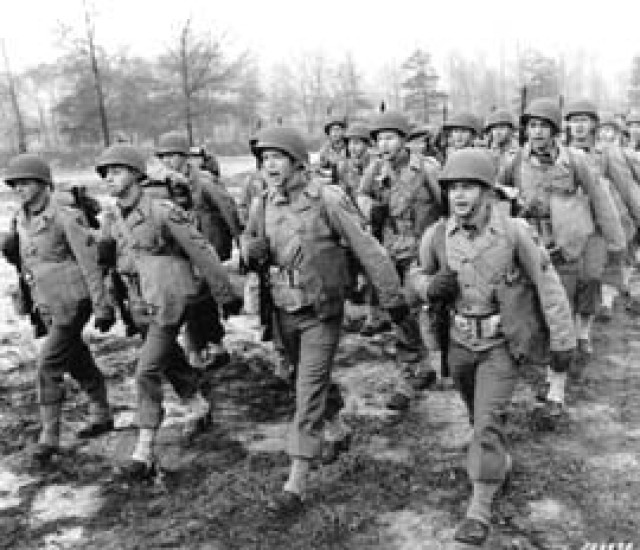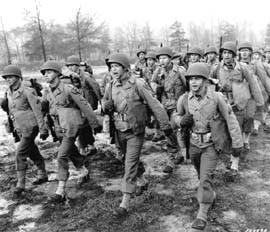FORT MONMOUTH, N.J. -- "I remember this song!" exclaimed William Scalzo with a broad grin. "I used to sing 'As The Caissons Go Rolling Along' all over Fort Bragg!"
Nostalgia continued to burst forth from an elated Scalzo as he eagerly examined other World War II (WW II) music recently featured at the Fort Monmouth Battle of the Bulge Chapter luncheon.
Assigned to the 286th Field Artillery Observation Battalion during WW II, the former field artillery observer reminisced about marching to "caissons" in the North Carolina heat while training.
"We sang the caissons song because we were the eyes and ears of the field artillery," said Scalzo. "But my favorite was 'Praise the Lord and Pass the Ammunition' because when you're fighting in a world war and don't have any ammo you're a goner!"
That was the case on Dec. 7, 1941, when Japan attacked Pearl Harbor.
As sailors scrambled to defend themselves from enemy planes, Chaplain Howell Forgy, aboard the USS New Orleans, encouraged the Americans by shouting "Praise the Lord and pass the ammunition."
It didn't take long for the well-known phrase to evolve into what became one of the most popular songs by Broadway producer Frank Loesser.
The song sold more than two million records and one million copies of sheet music. Fearful that the public would tire of it, the Office of War Information restricted its performance over the airwaves to once every four hours.
Drafted after his high school graduation, Scalzo was just 20-years-old when he landed in France. Too young at the time to drink liquor or vote, he was still able to enjoy all the sensational music of the time.
"I loved hearing Kate Smith sing 'God Bless America.' God bless you, Kate. I love your voice," Scalzo said. "Later, when I was wounded and lying in the hospital, all I heard was 'Sentimental Journey.' That really cheered me up."
Battle of the Bulge veterans were afforded the opportunity to view other WW II favorites such as "Don't Sit Under the Apple Tree" and "Coming in on a Wing and Prayer."
Hits from the Big Band and Swing Music era by Benny Goodman, Tommy and Jimmy Dorsey and Glen Miller music were also played throughout the luncheon.
So entrenched are those melodies many of the members had no problem remembering where and when they first heard the unique music that began emerging in the late 1930s.
As a high school student, Bill O'Brien still remembers seeing Glen Miller on a street one day in his Philadelphia community.
The magnetism of Miller's music had captivated O'Brien so much that the teenager was somewhat surprised the musician was smaller than he expected.
"I didn't expect him to have glasses either," said O'Brien, who declared he loved the new music the first time he heard it. "It was so unique with the expert balance of brass and woodwinds. And the melodies and words were incredibly catchy. Tunes that stayed in your head long after you heard the song."
"Moonlight Serenade," a tune O'Brien describes as amazing, is still his favorite and one he danced to while stationed in London during the war.
He insists the tunes made a huge difference during the conflict in that they were a source of comfort and morale builders.
"I was fortunate enough to serve with Soldiers who had musical talent," said O'Brien, 87th Infantry Division. "We used to sing those songs together for hours no matter where we were. They represented home and all the things waiting for us back there."
Larry Lynch was too young for WW II, but even at 11-years-old, he was fascinated by the Big Band sound and Swing music. The "Boogie Woogie Bugle Boy" by the Andrews Sisters quickly became his favorite due to its lyrics and high energy level.
"During the Korean War, I was stationed in Alaska and those wonderful songs became popular with us all over again," said Lynch. "I still dance to a likeness of the jitterbug called the 'Lindy.' The only difference is we don't throw our partners around."
As with many veterans from America as well as England and Germany, "Lili Marleen" remains a treasured tune for Lynch. And when the desire to hear more German music strikes him, he heads for a place called the Crystal Brook Resort in northern New York state.
"There are a lot of veterans that go there for that purpose," said Lynch. "Afterwards, I always ask the disc jockey to play 'Taps' in honor of those that didn't return from WW II and other conflicts."
As a student musician in New York City, Battle of the Bulge veteran Rudy Kreutzer played with Big Band orchestra musicians outside of their regular band performances.
According to Kreutzer, it's an experience he still treasures today and one that enhanced music for him.
"Although I'm more of a classical fan, I enjoyed those tunes. And the gentlemen that played them were highly skilled professionals," he said.
Although a country music fan, it didn't take long for Charlie Nelson, 87th Infantry Division, to develop an instant liking to the big bands. Listening to the radio and hearing the music at the movies is how Nelson came in contact with the new sound.
After joining the service, the small town Soldier visited the Stage Door Canteen in New York City, an experience he described as extraordinary.
"We were on a pass from Camp Kilmer and got to hear not only great music, but comedians as well," said Nelson. "They had great jokes and even though it was standing room only, we enjoyed ourselves very much. We were made to feel so welcome and appreciated for serving our country."
Looking back on that evening, Nelson added he would have loved to dance with the many young ladies available but the floor was too crowded.
Robert Godfrey, 106th Infantry Division, first heard and enjoyed the big bands and GI tunes from the radio show "Make Believe Ballroom Time."
One song is embedded in his memory forever.
"I was taken prisoner by the Germans during the Battle of the Bulge," said Godfrey. "The first song I heard after my release was 'Don't Fence Me In.' Because of my prisoner of war experience that piece has always stood out." "Don't Fence Me In" was recorded by many entertainers including Bing Crosby and the Andrews Sisters.
It sold over a million copies and topped the Bill Board charts for eight weeks in 1944-45. Other songs that became great favorites of WW II veterans include "What Do You Do In The Infantry'" and Hoagy Carmichael's "I'm a Cranky Old Yank In A Clanky Old Tank" written on behalf of the tankers fighting in Europe and the South Pacific.
"Cranky Old Yank" also holds the record for the longest titled song, "I'm a Cranky Old Yank In A Clanky Old Tank On The Streets Of Yokohama With My Honolulu Mama Doin' Those Beat-O, Beat-O, Flat-On-My-Seat-O, Hirohito Blues."
In the song, "Any Bonds Today'" by Irving Berlin, cartoon character Bugs Bunny sang and danced to promote the sale of government bonds in support of the war effort.
The 90-second animated feature was introduced on Arsenal Day, June 10, 1941, at the War College then located in Washington, D.C.
Bugs Bunny sings a portion of Berlin's song against a patriotic backdrop and for the song's last refrain, Porky Pig in a Navy uniform and Elmer Fudd in Army gear join in.
The song, "Johnny Zero" was based on John Foley, a typist serving in the Southwest Pacific during December 1941.
Eager for combat, Foley secured orders transferring him to duty as an armorer. He never received any aerial gunnery training but volunteered as a gunner and was assigned to the crew of a Martin B-26.
Japanese fighters attacked the aircraft on Foley's first mission.
Upon learning Foley had shot down two enemy planes during the battle, a war correspondent nicknamed Foley "Johnny Zero."
During 31 other Pacific combat missions, Foley shared in the destruction of at least six more enemy aircraft and survived three B-26 crashes.
Malaria forced Foley to return to the states in 1943. After his recovery, Foley joined the 409th Bomber Squadron in England. Volunteering to fly whenever he could, Foley completed a record 31 missions over Europe in 60 days. A hero in his hometown of Chicago, it didn't take long for the trendy song, "Johnny Zero" to follow.
As for why the music of the 1940s made such a distinct impression on WW II Soldiers, Charlie Nelson says it's because the songs represented home.
"My favorite, 'A String of Pearls,' reminded me of the better life back home. Certain ones made us laugh and others described perfectly the kinds of situations many of us were in. Other songs told about GI life and promoted heroism," he said.
"They made a difference to me as an American soldier in WW II because of all the marching. Singing those songs made you forget about your feet," add Scalzo
.
The proof that Big Band, Swing, and distinct GI songs are still as popular today as ever is evidenced by the fact that almost all Battle of the Bulge members as well as other veterans say they still listen to and enjoy the music from over 65 years ago.
"When's the last time I heard that spectacular music'" asked Bill O'Brien. "Yesterday!"
(Editors Note: This is the second story in a series featuring World War II novelties.)


Social Sharing